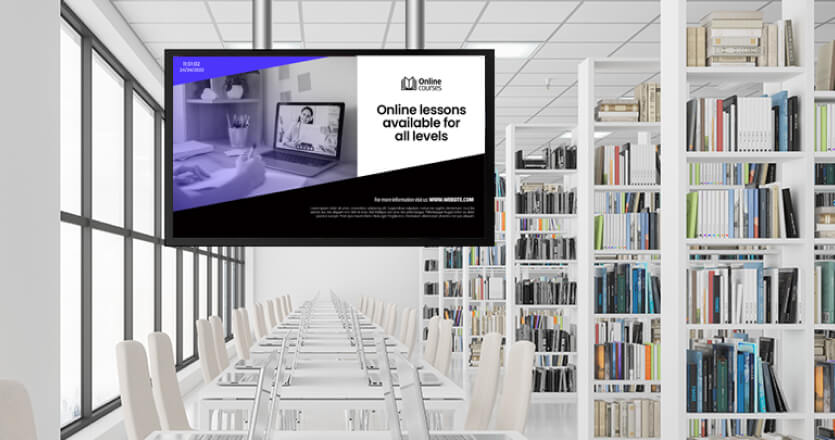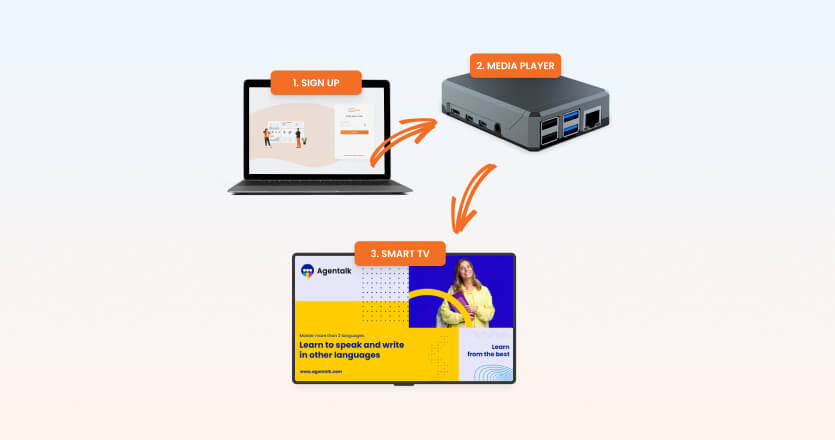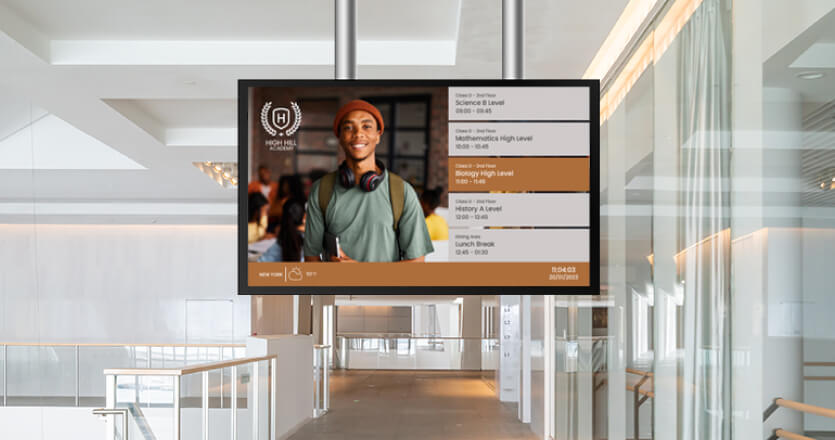When it comes to communicating important information in universities, we’re all familiar with the image: large posters or bulletin boards in hallways covered in dust, more often ignored than read. But in today’s digitized society, where we’re constantly glued to a digital display—whether our phones, computers, TVs or digital signs—we’re naturally drawn to colorful and vivid images, relegating paper to dullness with little to offer. As a result, universities have embraced a new form of communication that resonates with the newest generations and captures their attention easily and effectively: digital signage! The right digital signage content for universities can transform campuses into vibrant hubs of information and engagement. Let’s see how!
Types of digital signage content for educational institutions
Digital signage content is the perfect blend of information and visuals displayed on screens strategically placed in high-traffic areas, ensuring effective transmission of information to the audience. Within educational settings, the dynamic content of a digital sign includes:
University announcements
Announcements are incredibly important for universities, arguably the most critical aspect, and digital signage can ensure that information reaches everyone on campus promptly. The content ranges from impending deadlines and scholarship opportunities to campus closures or safety alerts and a notice board is perfect for this kind of content.
Event promotion
Digital signage can be a very effective tool for promoting a variety of events, including lectures, club meetings, career fairs, and social gatherings. Therefore, highlighting these activities on digital calendar displays encourages student and faculty engagement, resulting in a vibrant campus culture.
Wayfinding & campus maps
Another excellent use of digital signage in universities, and a must-have content display, is for wayfinding. It makes navigating large campuses easier, preventing students from getting lost or frustrated. Given that, students can easily identify classrooms, offices, and amenities, reducing confusion and improving time management for everyone.
Inspirational content
Celebrating the diverse achievements of students, from academic milestones to extracurricular accomplishments, alongside groundbreaking research endeavors by faculty and notable triumphs or alumni, creates a vibrant network of success within the community. Thus, this collective recognition not only infuses a deep sense of pride but also promotes inspiration, motivating upcoming generations to pursue their dreams.
Real-time data
Displaying updates such as library hours, cafeteria menus, bus schedules, and weather forecasts will ensure that students remain informed and organized amidst their academic endeavors. Consequently, this proactive approach to communication enhances the overall campus experience and fosters a sense of efficiency and convenience for all students.
Social media feeds
Embedding social media channels into your university’s digital signage improves student connectivity while also enriching campus culture by highlighting student life, current hashtags, and campus events. The effortless blending of online platforms and physical displays fosters greater engagement and community involvement, resulting in a lively, well-connected campus environment.

Exploring compelling usages of digital signage in university settings
Let’s look at some actual examples of how universities might use digital signage to enhance the campus experience:
- High-traffic areas: Transform noisy hallways, cafeterias, and public spaces into information transmission hubs. Use digital information boards to announce upcoming events, important deadlines, and information about student organizations, establishing a strong campus community.
- Libraries & study spaces: Set up digital signs to improve the ambiance of libraries and study corners. Highlight peaceful spaces for studying, library hours, and available resources, allowing students to maximize their academic potential.
- Classrooms & department offices: Digital notice boards can improve organizational efficiency in academic settings. Share full lecture schedules, faculty office hours, and relevant departmental announcements to ensure effective communication between teachers and students.
- Athletic facilities & gyms: Energize your fitness centers with gym digital signage. Advertise upcoming games, intramural sports opportunities, and wellness initiatives, fostering a vibrant culture of physical activity and health awareness.
- Dormitories & student centers: Cultivate a sense of belonging and involvement within residential spaces and student hubs. Highlight social gatherings, club meetings, career service workshops, and mental health support resources, nurturing holistic student development.
What do I need to get started with digital signage
The good news? You don’t need a complex setup! Here are the essentials:
- Digital signage displays: These are the physical screens displaying content. They come in various sizes and types, including LED, LCD, and OLED. The choice of display depends on factors such as budget, space availability, and intended usage environment.
- Media players: Media players are the devices responsible for delivering content to digital signage displays. They can be standalone units or integrated into the displays themselves. These players need to support various media formats and should be capable of smooth playback for high-quality content.
- Content management software: This software allows users to create, schedule, and manage content for their digital signage network. It should provide an intuitive interface for easy content creation and scheduling, as well as features for monitoring and updating displays remotely.
- Creative assets (graphics, videos): Compelling content is essential for engaging audiences. Universities need access to graphic design tools and video editing software to create visually appealing content that communicates their messages effectively.
- Screen placement: Placing digital signage screens is crucial for maximizing visibility and impact. Factors such as foot traffic patterns, viewing angles, and ambient lighting must be considered when determining the optimal display locations.
- Network connectivity: Reliable network connectivity is essential for delivering content to digital signage displays. Universities need to ensure that their network infrastructure can support the bandwidth requirements of their digital signage system and provide adequate coverage across campus.

Yodeck digital signage software solution
Yodeck offers a complete digital signage software solution specifically for educational institutions. With Yodeck, universities can easily create, manage, and deploy captivating digital signage content across campus facilities. Featuring intuitive drag-and-drop functionality, seamless content scheduling, and remote management capabilities, Yodeck streamlines the digital signage workflow, enabling universities to deliver dynamic visual experiences with ease. Moreover, Yodeck provides a wealth of customizable templates and apps, allowing universities to tailor their digital signage content to specific audiences and objectives.
